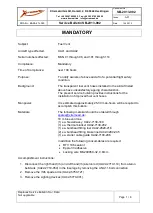
_
49
_
EN
_
48
General information on paragliding
As an aviation sport, paragliding and therefore the use of harnesses, is regulated.
Depending on your country of origin, instruction may be compulsory. Additionally,
there are statutory requirements (for example air law) which must be adhered to.
Paraglider pilots must be able to prove that they have valid licences and must have
insurance, as required by their country of residence. Pilots must be capable of jud-
ging meteorological conditions correctly. Depending on a country‘s applicable re-
gulations, the use of a helmet and back protector, as well as carrying a parachute,
is mandatory and highly advisable.
Pilots must accept responsibility for the risk inherent in participating in the sport.
Paragliding is an adventure sport and can lead to severe injuries and death. As a
manufacturer, we cannot be held responsible for an individual’s improper practice
and participation in the sport.
We recommend that inexperienced pilots and those with a heightened desire for
safety should undertake paragliding under the auspices of an accredited school or
instructor. Many of our NOVA Partners can offer this service.
Recommendations
Harness and wing are an important unit. One can only get the full potential from
a wing if it feels comfortable. If the wing is too demanding, this does not lead to
improved performance and it can increase the risks.
After buying a new wing we recommend undertaking an SIV/pilotage course. On
this course, we recommend practising the manoeuvres which simulate the inci-
dents which most commonly occur during everyday flying – in particular asymme-
tric and frontal collapses.
Furthermore, we recommend regular flying, groundhandling, as well as further the-
oretical training. We advise that you continuously study flight theory and practice
and that you also study the particulars of your chosen flying equipment. As the ow-
ner of your equipment, it is your responsibility to comply with checking and main-
tenance requirements.
More information on this in the »Care, repair and maintenance« section.
Preamble
The SOMNIUM is primarily aimed at pilots who demand performance. It offers a
high degree of passive safety combined with little weight and excellent aerodyna-
mic characteristics. The high level of comfort and the pod enhance the feeling of
comfort in the air.
Safety notices
• Our harnesses are developed and manufactured for paragliding. The harness is
designed for pilots weighing up to 130 kilograms (according to LTF certification).
Our harnesses are not suitable for freefall. The reserve bridle attachments are
not designed to withstand the loads of a freefall deployment.
• Pilots should adjust their harnesses on the ground, not in the air. Correct adjust-
ment is important and essential for safety.
• The impact protection fitted in the harness increases passive safety but it does
not offer complete or comprehensive protection against injury. The protection
mechanisms assist to cushion an impact and lower the risk of injury of a low level
impact. This is particularly relevant for accidents which occur during take off and
landing. The higher the impact force, the more limited the benefit of the protec-
tion.
• In the case of a water landing during an SIV/pilotage course, there is a danger
that the airbag floats to the surface and pushes the pilot’s head underwater. An
additional danger is that the airbag chambers fill with water and pull the pilot un-
der. Therefore an organised and rapid rescue from the water is essential..









































